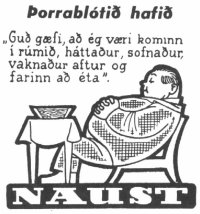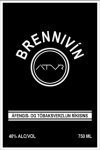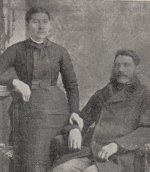The old old Icelandic calendar had 12 months - as we have today - but each month had 30 days. In the summer, between 18th to 24th July, four days called
aukanætur "additional nights", were added to the year to make it 364 days or exactly 52 weeks.
To make it all cronologically correct it was necessary to make a correction every fifth or sixth year by adding a week, called
sumarauki, to the aukanætur, so the leap year became 53 weeks.
The fourth month of winter, according to the old Icelandic Calendar, is
Þorri (Thorri). Before 1700 the month began on Friday between January 9 to 15. Nowadays on Friday between January 19 and 25. The beginning of Thorri marks the half-way point of winter.
|
|
 |
Advertisement for a Þorrablót in the restaurant Naust, 1959. The text, drawn from a humorous folktale, reads "I wish to God I had gone to bed, fallen asleep, woken up, and started eating again. |
|
The origin of the name is unclear. It has been known from the 12th century and could be derived from the name of
Thor, the ancient god (
Newsletter #33), but it can also be related to the Icelandic word "
þverra", meaning "come to an end". I.e. the winter starts to leave. Þorri Feast or Þorri Sacrifice, we call it
Þorrablót in Icelandic, occurring only vaguely in saga litterature, is probable some kind of midwinter celebration that was held in pagan times and
was reawakened as an occasion for feasting and poetry in the latter half of the 19th century. A secret society called Kvöldfélagið (the Evening Society) held its first Þorrablót in 1867.
During these years, when the movement for independence from Denmark was gaining strength in Iceland, a rose-tinted view of the ancient days of freedom led to a romantic tendency to revive pagan rites, such as the Þorrablót.
Icelanders did not enjoy full religious freedom until 1874, when they received their constitution. Anything that smacked of paganism and unorthodoxy had been much frowned upon during the puritan 17th and 18th centuries, and could actually be a criminal offence. But as soon as these restrictions were lifted in 1874, the first public Þorrablót was held in Akureyri, North Iceland. The custom gradually spread to other communities.
The custom of the Þorrablót was also carried to the
Icelandic-Canadian community in Winnipeg, which began to hold such events in the early years of the 20th century.
In a spectacular stroke of marketing inspiration, in the month of Þorri, 1958, the manager of Reykjavík restaurant
Naust introduced Þorri feasts, open to all. Traditional Icelandic food, such as
svið (pickled lamb's heads),
hangikjöt (smoked lamb),
hrútseistu (pickled ram's testicles),
hákarl (cured shark),
flatbrauð (cakes of rye bread cooked on a hot griddle), and sweetened
black rye bread were served, together with plenty of butter, in a wooden trug, a replica of one in the National Museum of Iceland. A penknife was supplied with which to eat the goodies. To gargle the throat in between, the Icelandic firewater, a schnapps called
Brennivín - commonly called
Svarti dauði or
The Black Death mainly because of the bottle's black label - is a necessity.
Ref.(mainly, as so often before) Árni Björnsson: "High Days and Holidays in Iceland"






